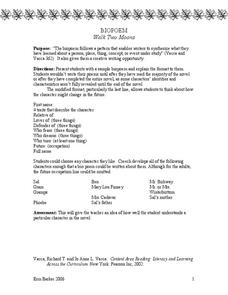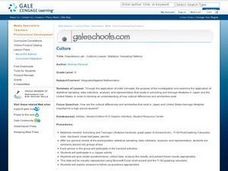Novelinks
Walk Two Moons: Biopoem
Middle schoolers describe the characters of Walk Two Moons as they write biopoems. Following the pattern provided, young writers depict their chosen characters' traits and experiences to make their poems unique.
John F. Kennedy Presidential Library & Museum
Red States/Blue States: Mapping the Presidential Election
Young historians investigate how voting patterns have changed by comparing the outcome of the 1960 election to the outcome of the recent election. A creative final assessment has participants making a news show wherein they provide...
Poetry4kids
How to Write a Haiku
A haiku is the focus of an activity that challenges scholars to draft an original poem. Authors discover the origin and components of a haiku, read three example poems, then follow six steps to compose their own.
American Museum of Natural History
Horse Gaits Flipbooks Walk, Trot, and Gallop!
Scholars follow seven steps to create horse-themed flipbooks. Three printable options allow them to choose from walking, trotting, or galloping scene.
EngageNY
Relationships Between Two Numerical Variables
Is there another way to view whether the data is linear or not? Class members work alone and in pairs to create scatter plots in order to determine whether there is a linear pattern or not. The exit ticket provides a quick way to...
It's About Time
Atoms with More Than One Electron
Provide young chemists with the ability to manipulate atoms and predict their results, in this sixth lesson. Pupils analyze energy patterns as they predict the amount of energy required to remove electrons from atoms. They compare trends...
Shodor Education Foundation
Sequencer
Take the first step into graphing sequences. Learners set the starting number, multiplier, add-on, and the number of steps for a sequence. Using the inputs, the interactive calculates and plots the sequence on the coordinate plane. Users...
Curated OER
Writing and Autobiography
Are you working on an autobiographical or narrative writing unit? Bring this lesson to your class, as it takes young writers through the process of drafting and sequencing an autobiography. After observing and demonstrating steps of the...
Curated OER
Dance Sequences and Phrases
A series of lessons about dance would be a great addition to your physical education class. Straightforward as well as creative, it teaches the basic skills of dance movement. A rubric helps guide the dancers to let them know what steps...
Curated OER
The 5 Paragraph Persuasive Essay
This PowerPoint highlights the steps one should follow to craft an organized essay. It addresses the purpose, audience, and format, and briefly touches on prewriting and organizing. This presentation is designed to review the very basic...
Pearson
Reading Comprehension Sequence Chain
Follow any story and record each step on the graphic organizer provided here. There are lines to record the title, author, and illustrator, boxes where pupils can fill in character and setting, and six boxes in which learners can note...
Curated OER
Algebraic Relationships
Here are 17 various forms of problems that range from matching equivalent expressions to word problems. Included are problems for substutiing values into expressions and using the order of operations, simplifying algebraic expressions,...
Curated OER
Ten More or Ten Less
Adding and subtracting 10 is easy once you understand the tricks! Learners first write numbers that are ten more than two double-digit numbers. Then, they find numbers ten less than two other double-digit numbers. An explanation on the...
Curated OER
Tides at the Battery, NY
Skill in using Excel and increasing proficiency in manipulating data are challenged with this data analysis work. A web link supplies data and step-by-step instructions help learners create a graph. There are many extension activities...
National Gallery of Canada
Transformation
Create colorful cool or warm butterflies with simple materials. Class members draw their designs, spray the marker to diffuse the colors, and attach pipe cleaners to form the shape of a butterfly with antennae. Individuals must be able...
Scholastic
Study Jams! Add & Subtract with Unlike Denominators
Your bakers might not realize that they need to know how to add with unlike denominators in order to figure out how much milk they need for a recipe. In order to make brownies and cookies, this lesson teaches how to find a common...
Pingry School
Gas Pressure and Temperature Relationship
Humans tend to huddle together when cold and move around more when warm, but do gas particles follow the same pattern? Scholars use a temperature probe, a pressure sensor, and air to study the relationship between temperature and gas...
Texas Center for Learning Disabilities
Second-Grade Comprehension-Based Intervention
Help your youngsters find meaning in the text they read with this series of five intervention lessons. Offering explicit, step-by-step instructions for walking children through shared readings of leveled books, these...
Curated OER
Populations Lab - Cultures Lesson: Statistics / Sampling Patterns
Ninth graders examine the application of statistical sampling, data collection, analysis, and representation that exists in schooling and teenage lifestyles in Japan and the United States.
Pingry School
Solubility Product of an Ionic Compound
How do scientists determine when a solution is fully saturated? Scholars address the topic as they observe patterns of precipitation in various concentrations of ions. Using a well plate, pipette, and common chemicals, they collect data...
Math in English
Skip Counting
Help young mathematicians take the next step toward fluent addition with a simple skip counting exercise.
Mathematics Assessment Project
Cross Totals
Finally, it all adds up. Learners complete a number puzzle in which they investigate the sums of the digits one through nine in a cross pattern. They then try to determine what totals are possible and which ones are not before devising a...
EngageNY
Sequencing Rotations
Discover the result of a sequence of rotations about different centers. Pupils perform rotations to examine the patterns. They also describe the sequence of rotations that performed to reach a desired result in the ninth installment in a...
LABScI
The Rutherford Atomic Model: Hidden Obstacles
Historically, scientists had to be creative to study subatomic structure. Scholars step into their minds to recreate the procedure Rutherford used to create his atomic model. Learners identify the creative efforts of early scientists...

























